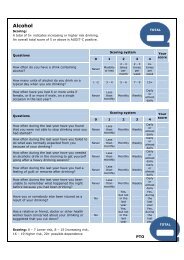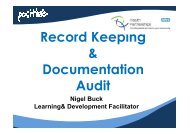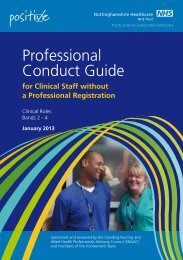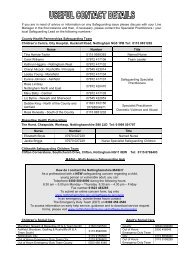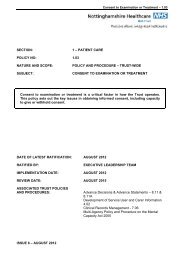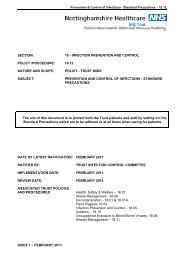Session 3 - Incident Reporting Policy - Health Partnerships Learning ...
Session 3 - Incident Reporting Policy - Health Partnerships Learning ...
Session 3 - Incident Reporting Policy - Health Partnerships Learning ...
Create successful ePaper yourself
Turn your PDF publications into a flip-book with our unique Google optimized e-Paper software.
Nottinghamshire Community <strong>Health</strong> aims to design and implement services, policies and<br />
clinical/non clinical procedures with measures that meet the diverse needs of our service,<br />
population and workforce, ensuring that none are placed at a disadvantage over others.<br />
All policies and clinical/non clinical procedures should be developed in line with the NHS Notts<br />
County Equality and Diversity <strong>Policy</strong> (2008), and need to take into account the diverse needs<br />
of the community that is served. The Equality Impact Assessment tool is designed to help<br />
consider the needs and assess the impact of the policy and clinical/non clinical procedure<br />
being developed (See Appendix F), and must be completed before approval/ratification can<br />
take place.<br />
13. Monitoring Compliance with the Document<br />
Nottinghamshire Community <strong>Health</strong> (through the Risk Management Team) will monitor the<br />
effectiveness of this policy through key performance indicators (KPIs) which will include an<br />
annual review.<br />
<br />
<br />
<br />
<br />
<br />
<br />
<br />
<br />
<br />
The process for involving and communicating with internal and external<br />
stakeholders to share safety lessons<br />
The process for following up relevant action plans; through reports from DATIX for<br />
low level risk and the work of the Q&RSC for higher level risks.<br />
NCH regularly uploads to the NPSA National <strong>Reporting</strong> <strong>Learning</strong> (NRLS) system<br />
Lessons learnt from analysis result in change<br />
Process for reducing risk identified through incident reports<br />
75% of incidents have a completed management action section within 2 weeks of<br />
the incident occurring<br />
Quarterly incident risk management reports contain incident and causal factors<br />
trend analysis<br />
At least 2 Lessons Learnt reports (Shared Experience Newsletters) are produced<br />
and disseminated each year<br />
An annual risk management report containing results of the audit and improvement<br />
actions is produced for the Q&RSC responsible for overseeing risk management<br />
14. References<br />
<strong>Health</strong> & Safety Executive. (1995). <strong>Reporting</strong> of Injuries, Diseases and Dangerous<br />
Occurrences Regulations (RIDDOR Explained, Version 6), Suffolk: <strong>Health</strong> and Safety<br />
Executive. Available at: http://www.hse.gov.uk/riddor/index.htm.<br />
<strong>Health</strong> and Safety (Consultation with Employees) Regulations 1996. (Statutory Instrument<br />
1996 No. 1513). London: The Stationery Office. Available at: www.opsi.gov.uk<br />
<strong>Health</strong> & Safety Executive. (1996). A guide to the <strong>Health</strong> and Safety (Consultation with<br />
Employees) Regulations 1996 (L95). Suffolk: <strong>Health</strong> and Safety Executive. Available at:<br />
www.hsebooks.com/<br />
Public Interest Disclosure Act 1998, Chapter 23. London: The Stationery Office. Available at:<br />
www.opsi.gov.uk<br />
Department of <strong>Health</strong>. (1998). <strong>Health</strong> Service Circular 1999/198, The Public Interest<br />
Disclosure Act 1998: Whistle blowing in the NHS. London: Department of <strong>Health</strong>. Available at<br />
www.dh.gov.uk/<br />
Page 14 of 28



